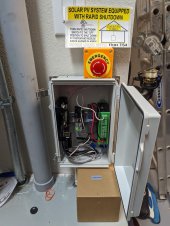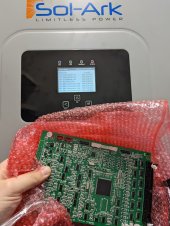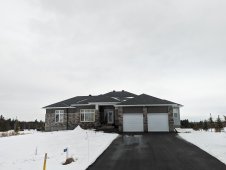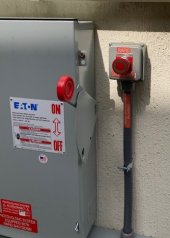Sol-Ark can be installed and configured in many different ways. The 12 VDC output on pins 15 & 16 is limited to 100ma. A clean and simple solution is to connect a low current 12VDC relay to those pins and connect the relay contacts to the CCA aux terminals. The CCA can remain powered on continuously. Tigo sells the CCA in a NEMA 3R enclosure that contains a DIN rail. A relay like this can be installed inside the enclosure with the DIN power supply and CCA:
Activating the RSD via the button shuts off the inverter output and pins 15 & 16, but does not disconnect the GRID to LOAD which may or may not be the desired intention. Throwing the main service disconnect ahead of the Sol-Ark may or may not shutdown or island the inverter depending upon your configuration.
The purpose of the RSD button is to cut power outpower from the panels on the roof.
The purpose of the main disconnect is to disconnect the PV system from the grid.
I did exactly this setup, thanks to your post! I also added my solar-assistant to a DIN rail mount so it fits in the box nicely.

My CCA is powered from a 15A breaker in my load breaker box that also runs a room's lights so it stays powered as long as there is power to be had either from grid, PV or battery.
If I lose grid, and my battery runs out at night, I am planning to do the exact same thing that @eia2022 is doing, lower the battery cutoff threshold and "jumpstart" the system. I also have a few cars I can pull 12V should I need to run the CCA off of something else other than the battery backup.
The only issue I ran into was that shorting pin 11-12 would only turn off the relay for about 30 seconds then it would turn it back on momentarily for a second or so at times and the Sol-Ark had no indication that the PV was shut down at all or any kind of RSS has happened.
I contacted Sol-Ark thinking it was a possible firmware bug and they identified that my inverter needed a new MCU. I swapped in the new MCU this morning and now if I push the emergency shutdown button I lose all power in the house and my Tigo also shuts down, I also get an F22_Tz_EmergStop_Fault which is the expected behavior.
If your system stays on with pin 11-12 shorted then your RSS is not working properly.







